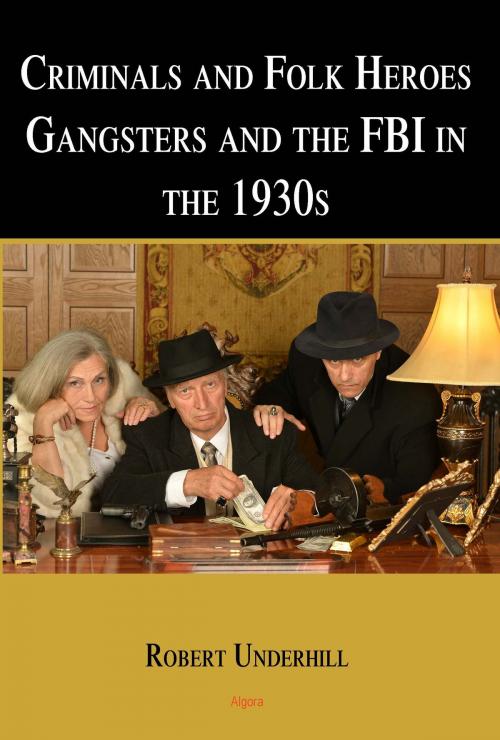| Author: | Robert Underhill | ISBN: | 9781628941401 |
| Publisher: | Algora Publishing | Publication: | January 5, 2015 |
| Imprint: | Algora Publishing | Language: | English |
| Author: | Robert Underhill |
| ISBN: | 9781628941401 |
| Publisher: | Algora Publishing |
| Publication: | January 5, 2015 |
| Imprint: | Algora Publishing |
| Language: | English |
During the Great Depression, writers of True Crime could take the decade off: life was imitating art so dramatically they had nothing to add. In these pages historian Robert Underhill presents the most notorious criminals of 1930-1934: Wilbur Underhill, Alvin Karpis, the Barker Clan, Pretty Boy Floyd, Baby Face Nelson, the Barrows (Buck, Blanche, Clyde, and Bonnie), and John Dillinger along with supporting material on their henchmen and the rise of the FBI.Often armed better than the police, criminals of the 1930s committed deeds ranging from stealing chickens to kidnappings, bank robberies, and killing innocent victims. Yet such crimes were often taken in stride by avid readers. Cooperation among local, state and federal lawmen was rare as each sought to protect his own turf. Criminals and lawmen made mistakes battling one another, but in most cases the law triumphed and the wanted fugitive died under a hail of bullets. His death would start myths and raise his reputation to national status.The author of 'Against the Grain: Six Men Who Shaped America' and 'The Rise and Fall of Franklin D. Roosevelt' shows us another aspect of the Roosevelt era and portrays a series of figures who contributed to pop culture as well helping to shape the security forces in America. Robbing the banks and driving fast cars, they did what many Americans dreamed of, and gave a depressed populace some excitement to distract from everyday worries.With the Great Depression, some citizens came to regard bank robbers as modern Robin Hoods seeking to avenge depositors whose life earnings had been wiped out by a bank's failure or malfeasance by its owners. No small wonder that criminals were given colorful sobriquets and fact and fiction became intertwined.Underhill shows how such heists, and kidnappings especially, helped create the modern FBI, overcoming the complaints of those who alleged that a federal force was the first step toward an American Gestapo. The belief that federal government had nothing to do with fighting crime was rooted in the U.S. Constitution and its provisions for states' rights. Local police were expected to provide security and to apprehend criminals without Washington getting involved.In the big cities, Prohibition era mobsters still ruled, but in the Midwest especially, smaller bands, "gangsters," began to make headlines. They tended to be blue-collar criminals whose favorite targets were filling stations, grocery stores, and small town banks. Prior to 1930, corruption was rife and cooperation among local, state, and federal police was little to none; criminals often got away. Only in 1935 was the FBI formally anointed and its agents were permitted to carry guns. Now, there was a federal agency that could supply sheriffs all over the country with information on suspected criminals.By 1935, the hardest times of the Depression were beginning to ease and the thrill of watching these cops-and-robber stories play out was combined with a renewed interest in the lives of the rich and famous, previously scorned for their role in ripping off the average man. All in all, the early 1930s were a uniquely dramatic time for crime and crimestoppers in America.
During the Great Depression, writers of True Crime could take the decade off: life was imitating art so dramatically they had nothing to add. In these pages historian Robert Underhill presents the most notorious criminals of 1930-1934: Wilbur Underhill, Alvin Karpis, the Barker Clan, Pretty Boy Floyd, Baby Face Nelson, the Barrows (Buck, Blanche, Clyde, and Bonnie), and John Dillinger along with supporting material on their henchmen and the rise of the FBI.Often armed better than the police, criminals of the 1930s committed deeds ranging from stealing chickens to kidnappings, bank robberies, and killing innocent victims. Yet such crimes were often taken in stride by avid readers. Cooperation among local, state and federal lawmen was rare as each sought to protect his own turf. Criminals and lawmen made mistakes battling one another, but in most cases the law triumphed and the wanted fugitive died under a hail of bullets. His death would start myths and raise his reputation to national status.The author of 'Against the Grain: Six Men Who Shaped America' and 'The Rise and Fall of Franklin D. Roosevelt' shows us another aspect of the Roosevelt era and portrays a series of figures who contributed to pop culture as well helping to shape the security forces in America. Robbing the banks and driving fast cars, they did what many Americans dreamed of, and gave a depressed populace some excitement to distract from everyday worries.With the Great Depression, some citizens came to regard bank robbers as modern Robin Hoods seeking to avenge depositors whose life earnings had been wiped out by a bank's failure or malfeasance by its owners. No small wonder that criminals were given colorful sobriquets and fact and fiction became intertwined.Underhill shows how such heists, and kidnappings especially, helped create the modern FBI, overcoming the complaints of those who alleged that a federal force was the first step toward an American Gestapo. The belief that federal government had nothing to do with fighting crime was rooted in the U.S. Constitution and its provisions for states' rights. Local police were expected to provide security and to apprehend criminals without Washington getting involved.In the big cities, Prohibition era mobsters still ruled, but in the Midwest especially, smaller bands, "gangsters," began to make headlines. They tended to be blue-collar criminals whose favorite targets were filling stations, grocery stores, and small town banks. Prior to 1930, corruption was rife and cooperation among local, state, and federal police was little to none; criminals often got away. Only in 1935 was the FBI formally anointed and its agents were permitted to carry guns. Now, there was a federal agency that could supply sheriffs all over the country with information on suspected criminals.By 1935, the hardest times of the Depression were beginning to ease and the thrill of watching these cops-and-robber stories play out was combined with a renewed interest in the lives of the rich and famous, previously scorned for their role in ripping off the average man. All in all, the early 1930s were a uniquely dramatic time for crime and crimestoppers in America.















